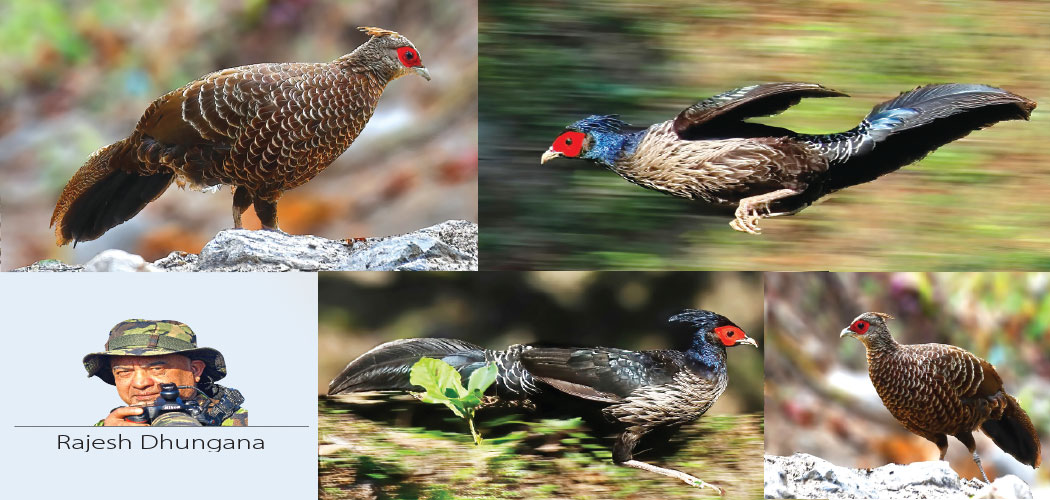- Saturday, 3 January 2026
Status Of Kalij Pheasants In Nepal
The Kalij Pheasant is a gorgeous and attractive bird found in different national parks and community forests of Nepal. This bird inhabits the foothills and high mountains of Nepal. They may hybridise in close association with the silver pheasant (Lophura nycthemera). In Nepali, this bird is called Kalij, and its scientific name is Lophura leucomelanos.
Various habitat types, such as evergreen and deciduous forests in dense subterranean valleys, are home to Kalij. It is the most widely distributed member of the Kalij family in Nepal. The first record of this bird was made in 1793 during research on the birds of Nepal. As this bird has spread widely in Nepal, people have reared it and started a meat business.
The Kalij Pheasant has several races (nine recognized subspecies) that differ widely in appearance but interbreed freely in areas of occasional overlap between them. Adding to the complexity, its sibling species, the Silver Pheasant, shows a similar degree of variation. The races of Kalij and Silver Pheasants that occupy adjacent areas sometimes interbreed and resemble one another more than they resemble distant races within their own species. Genetic tests strongly support the separation of these intermediate races and all Kalij-Silver races into two species. The Shivapuri-Nagarjuna National Park and its surrounding areas in the Kathmandu Valley are the most common places to see this bird.
Research conducted by the Nepal Ministry of Forest and Environment Pheasant Conservation Action Plan for Nepal 2019–2023 records eight species of pheasants in Nepal. They include Common Peafowl (Pavo cristatus), Red Junglefowl (Gallus gallus), Himalayan Monal (Lophophorus impejanus), Satyr Tragopan (Tragopan satyra), blood pheasant (Ithaginis cruentus), cheer pheasant (Catreus wallichii), koklass pheasant (Pucrasia macrolopha), and kalij pheasant (Lophura leucomelanos). The Constitution of Nepal has declared the Himalayan Monal (Lophophorus impejanus) as a national bird, while the NPWC (National Park and Wildlife Conservation) Act 1973 has included the Cheer Pheasant, Himalayan Monal, and Satyr Tragopan under Schedule I: List of Protected Birds of Nepal.
Though being a common bird, very little information is available on their ecology and population status of pheasants among the scientific and conservation fraternity. Despite a few sporadic studies, many areas remain unexplored. Thus, there is a need to undertake a detailed study on the population and ecology of pheasant communities. The IUCN Red List categorises many pheasant species as being least concerned due to their large-scale distribution. However, two species, namely Cheer Pheasant and Satyr Tragopan, are categorised as vulnerable and near-threatened, respectively.
Nationally, three species of pheasants Cheer Pheasant, Satyr Tragopan, and Koklass Pheasant) are classified as threatened and two others (Himalayan Monal and Common Peafowl) are near threatened. Other three species (Red Junglefowl, Blood Pheasant, and Kalij Pheasant) are listed as least concerned. Many pheasant species do not have a desirable conservation focus targeted towards them. Limited resources are available for their research and conservation initiatives, thus leading to a low level of conservation awareness. In this context, the pheasant conservation action plan (2019-2023) has been prepared with the goal of increasing the population of the species and protecting their habitat.
Features
Combination of different colours makes Kalij pheasant gorgeous. The adult male has bright blue-black plumage. It has a purplish to greenish wash and distinctive broad white scales on the underside of the upper tail covers. Wings and vents are blackish-brown and often lusterless. The tail is blue-black above and shiny black below. Its breast is grey to grayish-white, but there is considerable variation in breast color. The head, forehead, crown, and bells are blue-black, edged with black. We can see very long blue-black feathers on this bird. This bird forms a long crest on the crown of its back. Bright red-to-red wattles appear on the face.
The length of the male is 63 to 74 cm, and that of female is 50 to 60 cm. They usually live in pairs. The tail of a female Kalij is smaller than that of a male. Females also have a rounded body structure.
Habitat and breeding
Kalij primarily emits a whistling or chirping sound in a circular tone during the morning and evening hours. When disturbed, it emits a squealing sound akin to that of a guinea pig. Kalij is an omnivorous bird. It eats various food items such as grains, small snakes, termites, figs, yams, acorns, ripe fruits, and other plants. Most of them sleep in the weeds and search for food only on the ground. They seek food by scratching the leaves with their paws. This bird lives in a quiet environment and searches for food only in the morning and evening. If the environment is calm and they feel safe, they search food even during the day.
During the breeding season, males perform normal courtship displays. Males also create a drumming sound by flapping half-open wings over their bodies. The display call enhances the plumage structure by spreading the wings and tail. Calls and other sounds accompany them. Various sounds accompany these performances.
Breeding takes place in March and April and nesting starts in May and June. Incubation starts in June and July, and most hatching occur at the end of June and July. Grass and cherry pine leaves made up the nests. The female lays 7 to 9 eggs. When the chicks hatch, the male and female protect the chick together.
According to senior ornithologist and conservationist Dr. Hem Sagar Baral, the Kalij Pheasant is a fairly common species in Nepal, found from the Churia foothills up to elevations as high as 3,700 meters. It is a forest-dwelling species and one of the most heavily hunted birds in Nepal. There are three subspecies of Kalij in Nepal, distributed from east to west.
Nepal is home to a total of eight pheasant species, with the Kalij Pheasant being the most widely distributed among them. The Government of Nepal has published an action plan to protect Kalij and other pheasant species. This was an important and unusual step taken by the Department of National Parks and Wildlife Conservation. Shivapuri Nagarjun and other national parks are well-managed, particularly in terms of reducing hunting and trapping. Such management has been the main reason for the thriving population of Kalij Pheasants in these areas.
Threats
Pheasants are some of the most hunted bird species in Nepal. Conservation threats to pheasants overlap in most cases and include illegal hunting, trapping for meat, use of body parts for age-old traditional healing practices and pet keeping. Deforestation and forest fires are also known to be direct threats affecting pheasants.
(The author is a wildlife photographer. The photos used in this article are by the author.)

















